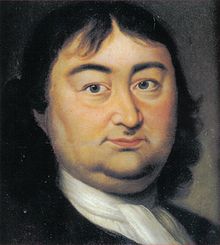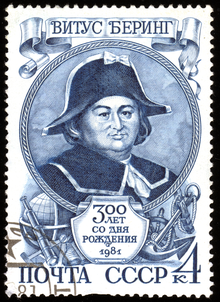Vitus Bering

Vitus Jonassen Bering (Russian Витус Ионассен Беринг Witus Ionassen Bering or Иван Иванович Беринг Ivan Ivanovich Bering ; baptized on August 21, jul. / 31 August 1681 greg. In Horsens , East Jutland, † December 8 jul. / 19 December 1741 greg . on Awatscha, the Bering island ) was a Danish naval officer in the Russian service. From 1728 to 1730 he led the First Kamchatka Expedition and from 1733 the Second Kamchatka Expedition , on which he died. The "Columbus of the Tsar" proved, among other things, that Asia and North America are not connected to one another.
Life
When he was 18, Bering began to go to sea. He received lessons in Amsterdam. In 1703 he was hired by Peter I as sea captain of the newly formed Imperial Russian Navy in Kronstadt (Russia) . From 1704 to 1724 he led the ships of the line of the Baltic fleet and the Azov flotilla . He took part in the fighting in the Third Northern War against Sweden and in the Russo-Turkish War . In 1725 he was in charge of the First Kamchatka Expedition of Russia, which was supposed to prove the existence of a strait between Asia and America in the Kamchatka Sea .
After his arrival in Nizhne-Kamchatsk in 1728, Bering had the 18-meter-long sloop St. Gabriel built. With this ship he examined the coast of Siberia in a northerly direction from July 1728 , discovered some islands and penetrated further and further into the Arctic Ocean without finding a land connection between Asia and America. On August 26, 1728, Bering gave the command to turn around due to bad weather and turned around at 67 ° 18 'north latitude. Although he had already crossed the strait that was later named after him, he did not provide the final proof that there is no land connection between Asia and North America.
After his return to Saint Petersburg in 1730, Bering was promoted to captain-commander, but also received a lot of criticism for not having fully completed his mission. Bering therefore himself proposed a second, larger-scale expedition, which was to pursue three main goals: the final clarification of the question of whether there was a land route to America, the exploration of the American coast and that of the sea route to Japan. These three points were of very high geopolitical interest to Russia at the time. In 1733 Bering became head of the Second Kamchatka Expedition , also known as the Great Nordic Expedition (1733–1743).
During this expedition, the German historian Gerhard Friedrich Müller , a member of the Petersburg Academy of Sciences, discovered that Bering was by no means the first seafarer to cross the Bering Strait in 1728. In the archives of the Yakutsk Chancellery he found evidence that the fur hunter and trader Semyon Deshnev had crossed the strait between the two continents with his men years before .
On June 15, 1741, Vitus Bering set sail with the approximately 24 meter long ships St. Peter and St. Paul to explore the coast of America. He was the first European to discover Alaska . Once there, Bering had some water barrels filled and wanted to start the way back. The resulting dispute with the German naturalist Georg Wilhelm Steller did nothing to change the fact that anchors were lifted just a few hours after arriving in America and the journey home was started. On the way back to Kamchatka, the St. Peter got caught in a heavy storm and stranded on the coast of the Avacha Island , which was later renamed the Bering Island . Due to the deteriorating weather, Bering and his team were forced to hibernate on this island. On December 19, 1741 Vitus Bering probably died here of exhaustion and cold. 18 other crew members also did not survive this wintering.
Bering examined and mapped the Arctic and Pacific coasts of Russia and the coast of Alaska up to latitude 69 ° north. He discovered several Aleutian Islands as well as the Commander Islands . Eleven geographical locations are named after Vitus Bering, for example the Bering Strait and the Bering Sea , as well as the Bering culture (a phase of development of the Eskimos ).
In 1991, Bering's grave and the graves of five other sailors were opened by a Russian-Danish expedition team, the remains were transported to Moscow and examined forensically. When his teeth were examined, no signs of scurvy could be found, so that another disease must have caused Bering's death. Georg Wilhelm Steller had already written: "He was more likely to die of hunger, cold, thirst and grief than of scurvy or any other illness." According to the forensic examination, the immediate cause of death was heart failure .
literature
- V. Andreev: Documenty po ekspeditsii kapitan-komandora Beringa v Ameriku v 1741 g . [Documents about Commander Bering's expedition to America in 1741], in: Morskoi sbornik, No. 5, St. Petersburg, 1893.
- Aleksandr I. Andreev [Andreyev]: Ekspeditsiia Beringa [Bering's Expedition] , in: Izvestiia VGO, tom 75, vyp. 2, Leningrad, 1943, pp. 3-44.
- Karl Ernst von Baer: Bering i Chirikov , in: Russkii invalid, nos. 121–123, St. Petersburg, 1849.
- Nikolai K. Chukovskii: Bering: Biografiia [Bering: A Biography], Pacific Northwest Quarterly, Vol. XXXVIII, 1961.
- Raymond H. Fisher: Bering's Voyages, Whither and Why , 1977.
- Orcutt William Frost: Bering: The Russian Discovery of America , Pacific Northwest Quarterly 86, No. 1, winter, 2003.
- Frank A. Golder: Bering's Voyages. An Account of the Efforts of the Russians to determine the Relation of Asia and America , 2 vols., Polar Geography and Geology 7 (July-September), 1922-1925.
- Peter Lauridsen: Vitus J. Bering og de russiske Opdagelsesrejser fra 1725–43 [Vitus J. Bering and the Russian voyages of discovery from 1725–43], Copenhagen 1885, American Anthropology 87, no. 4 (December), 1985 ( online ).
- VD Lenkov, Silantev: The Komandorskii Camp of the Bering Expedition , edited by OW Frost, translated by Katherine L. Arndt, American Anthropology 87, No. 4 (December), 1992.
- Georg Wilhelm Steller : Journey from Kamchatka to America with the Commandeur-Capitän Bering , Saint Petersburg 1793, published by PS Pallas ( online ); Reprinted as ( Historische Schiffahrt , Volume 72) at Salzwasser, Bremen 2009, ISBN 978-3-86195-056-1 .
- P. Werner Lange : To the land behind the mists. The life of Vitus Bering and the two Kamchatka expeditions , VEB FA Brockhaus Verlag, Leipzig 1985
- Olivier Remaud : Errances , Paulsen 2019 ISBN 978-2375020623
Web links
- Vitus Bering at the Museum Horsens ( Memento from July 22, 2007 in the Internet Archive )
- Bering in Danish , University of Copenhagen (Danish)
- Toke Nørby: The Columbus of the East, The Vitus Bering Stamps and First Day Covers from Denmark (PDF; 349 kB), The Posthorn , Scandinavian Collectors Club, May 2000, pages 3–9
- Biographies , Chronos (Russian)
- Vitus Jonassen Bering , Arktika Antarktika Filatelija (Russian)
- WGSebald: Bering and Steller
Individual evidence
- ^ Entry in the parish register of the township of Horsens (Our Savior's Church, Danish: Vor Frelsers Kirke). In the church book (page 26) the date of baptism is given as the 12th Sunday after the Trinity in 1681. This corresponds to August 21, 1681 according to the Julian calendar then used in Denmark.
- ↑ Britannica Concise (English) ( Memento of the original from January 18, 2008 in the Internet Archive ) Info: The archive link was inserted automatically and has not yet been checked. Please check the original and archive link according to the instructions and then remove this notice.
- ↑ http://www.seemotive.de/html/dbering.htm
- ^ Orcutt W. Frost: Bering - The Russian Discovery of America. Yale University Press, New Haven and London 2003, ISBN 0-300-10059-0 , pp. 7 and 237 , accessed on Google Books on December 20, 2016.
| personal data | |
|---|---|
| SURNAME | Bering, Vitus |
| ALTERNATIVE NAMES | Bering, Vitus Jonassen (full name); Columbus the Tsar (nickname) |
| BRIEF DESCRIPTION | Danish navigator in Russian service, discoverer of the Bering Strait |
| DATE OF BIRTH | baptized August 31, 1681 |
| PLACE OF BIRTH | Horsens , East Jutland |
| DATE OF DEATH | December 19, 1741 |
| Place of death | Bering Island |


